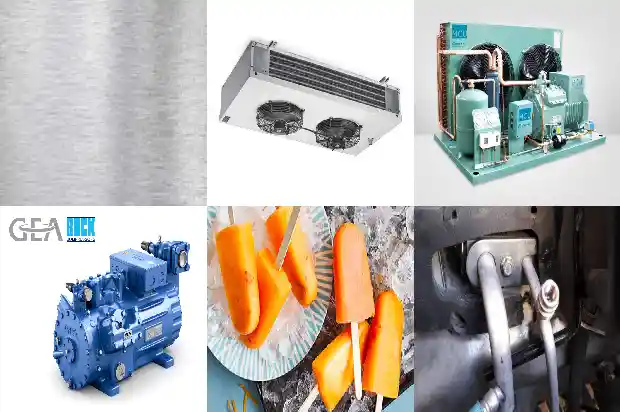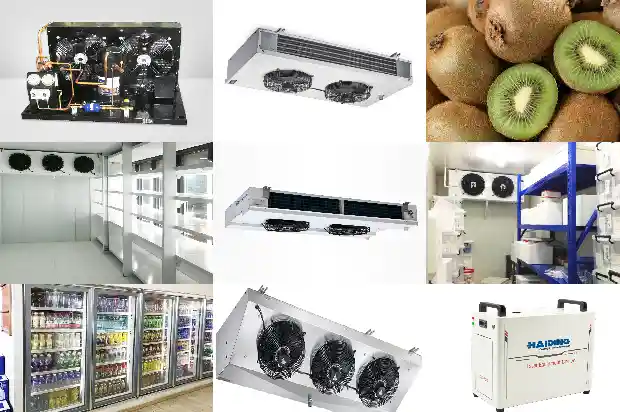Oil Cooling Methods and Oil - changing Operation Procedures for Screw Compressors
2025-02-25
I. Common Oil Cooling Methods for Screw Machines
(1) Water - cooled Oil Cooler
The water - cooled oil cooler is a horizontal shell - and - tube heat exchanger. Oil is outside the tubes, and water is inside the tubes. The tube bundle is fixed on the tube plates at both ends.

(2) Thermosiphon Oil Cooler
The structure of the thermosiphon oil cooler is similar to the principle of the water - cooled oil cooler. It is a horizontal shell - and - tube type, with oil outside the tubes and refrigerant inside the tubes. The temperature of the oil cooled by the thermosiphon oil cooler is generally 10 - 20°C higher than the condensing temperature.
(3) Liquid Injection Cooling
In units with liquid injection cooling, high - pressure refrigerant liquid led out from the condenser or liquid receiver passes through a filter, a throttle valve or a high - temperature expansion valve, and then is sprayed into a certain intermediate orifice of the compressor. This serves to absorb the heat of compression and cool the oil temperature.
(4) Air Cooling
The air - cooling system is an indirect cooling method. It cools the oil in the oil cooler through the ambient air.
II. Operation of Lubricating Oil Replacement
- Recover the system refrigerant to the condenser side, exhaust the refrigerant in the compressor, and drain the refrigeration oil from the oil - drain angle valve of the compressor.
- Drain the lubricating oil of the compressor from the oil - drain valve on the oil filter. When the lubricating oil is almost drained, introduce a certain amount of nitrogen from the high - pressure side detection joint of the compressor. Use pressure to accelerate the discharge of the lubricating oil. Stop injecting pressure and close the oil - drain valve. Then, remove the oil filter of the compressor, drain all the lubricating oil in the oil sump, clean the oil filter, and reinstall it and tighten it.
- Add lubricating oil according to the standard amount of the compressor. At the same time, evacuate the system. It is recommended to select the high (low) - pressure side angle valve or other relatively high - position points as the connection point of the vacuum pump to prevent damage to the vacuum pump by sucking in the refrigeration oil.
When conducting vacuum pressure - holding or leak - checking, observe whether the pressure rebounds.

- Inject lubricating oil. Connect a clean plastic tube to the oil - drain valve, and place the other end of the plastic tube at the bottom of the oil drum. When injecting oil, the oil drum should be sealed to reduce the pollution of the oil by air.
Related Articles
- Causes and Solutions of Ice Blockage, Dirt Blockage and Oil Blockage
- Which is Better for Cold Storage: Cooling Coils or Air Coolers?
- Has Your Refrigeration System Experienced "Oil Carry - over"?
- Causes and Prevention of "Primary Condensation" and "Secondary Condensation" in Fan - Coil Units
- Common Faults of HVAC Fan Coil Units
- Introduction to Oil Collector in Refrigeration System
- Forms of Oil Separators
- How to troubleshoot dirty blockage, ice blockage and oil blockage in refrigeration systems?
- Installation and Oil Return Precautions for Refrigeration Equipment Pipelines
- Precautions for Replacing Refrigeration Compressor Refrigerant Oil
- What are the reasons for the poor oil return of screw compressors?
- Freezing Chamber System Blockage, Dirty Blockage, and Oil Blockage Characteristics and Treatment Methods
- Oil Cooling Methods and Oil Leakage Operations for Screw Compressors
- Types of Refrigerants and Leak - detection Methods
- Introduction to Inspection and Handling Methods for Refrigerant Leak in Cold Storage
- Three Common Methods for Removing Water Scale from Water - cooled Condensers
- Reasons for Frost Formation in Cold Storage and Defrosting Methods
- Maintenance Methods for Small Modular Cold Storage Failures
